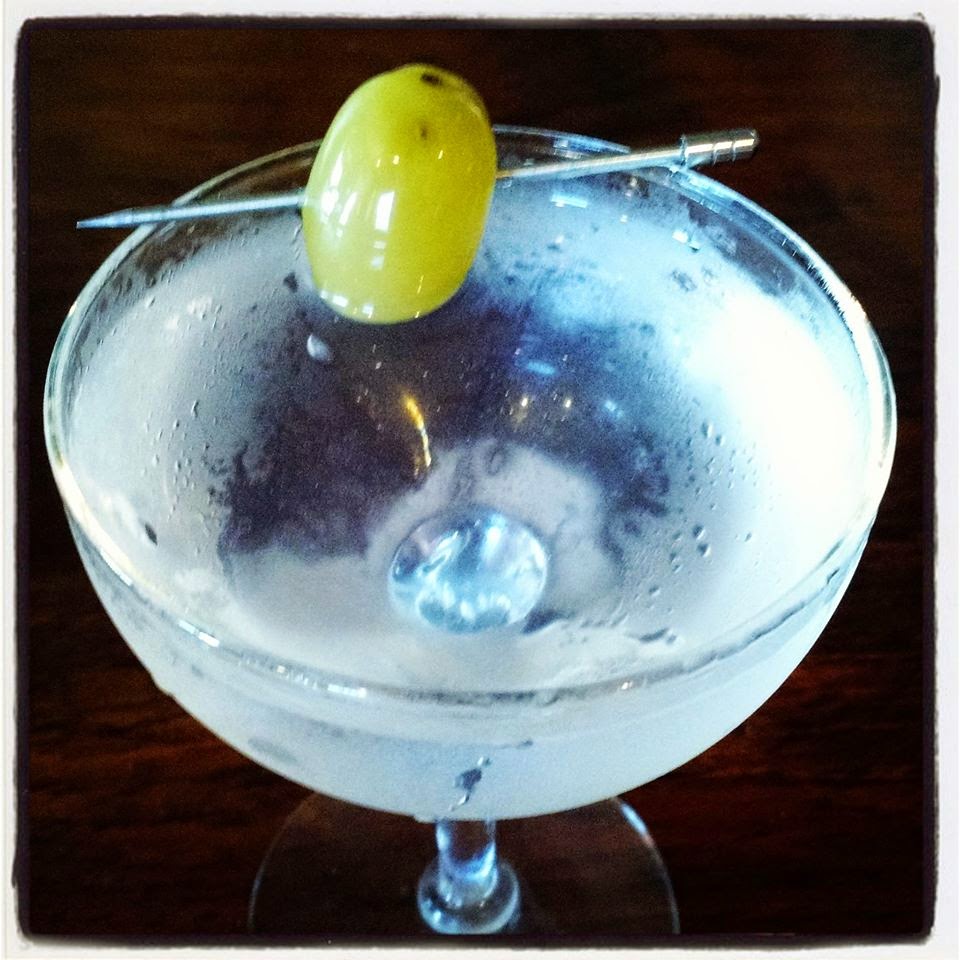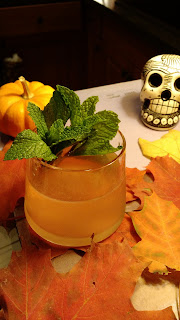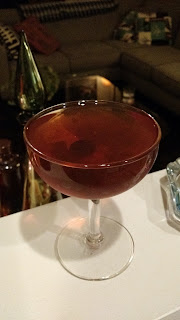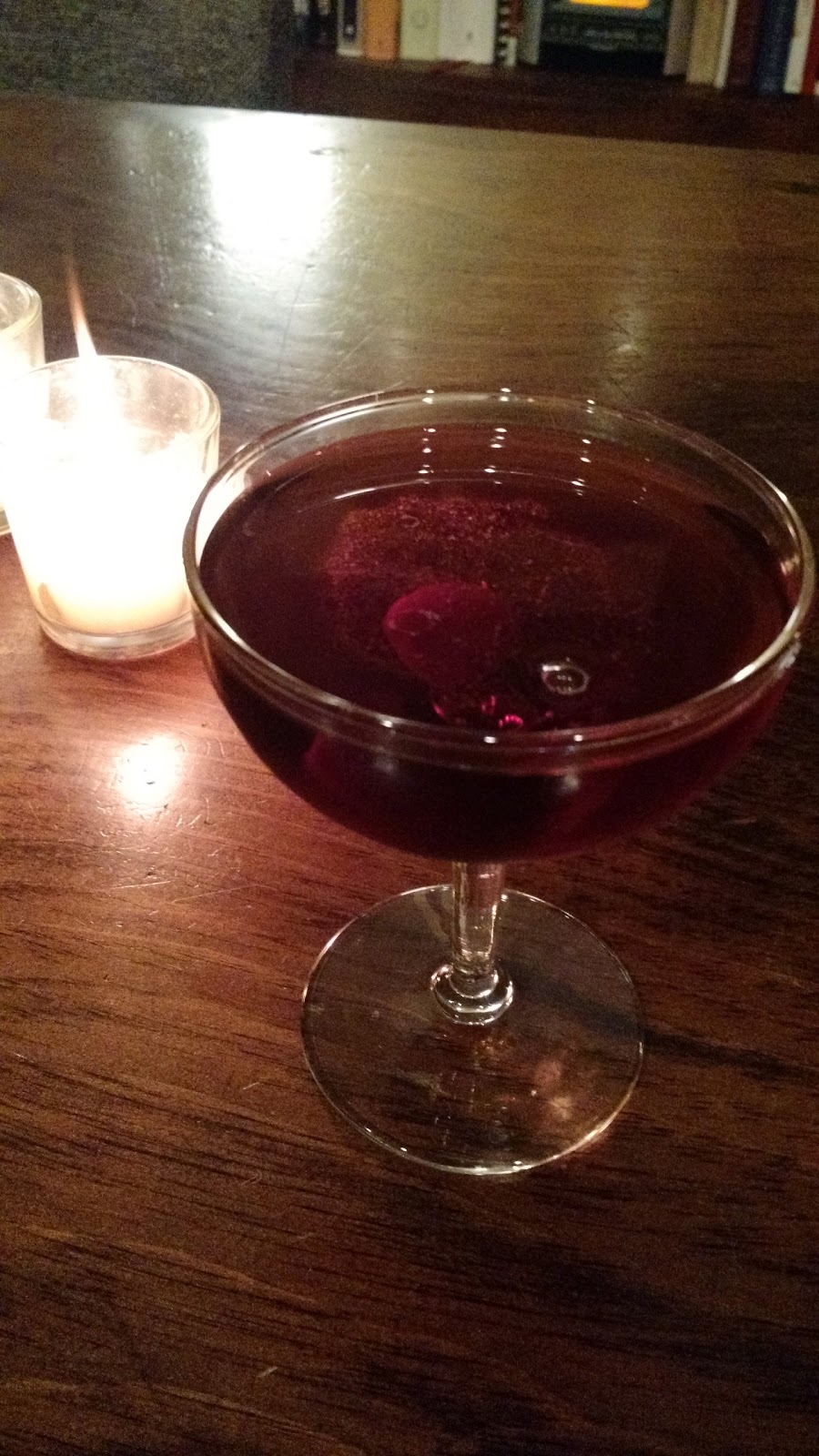It is feasible that one could dedicate the rest of his or her time on this planet researching the origins of the famed Martini—"King of Cocktails." Clues to its creation abound, but so do dead ends, follies, and inconsistencies.

The recipe I am posting here is not for today's typical dry Martini—though it is dry compared to the earliest iterations of the drink, which date to the mid-1800s—since this version probably has far more vermouth in it than any self-proclaimed dry Martini aficionado would tolerate. No, rather than merely washing the ice, or swirling and discarding the vermouth, or opening the cap and allowing the fan to blow the essence across the glass, this calls for a full half ounce of a good dry vermouth. And it even has bitters in it.
I realize that some basic Martini background and lore may be necessary.
For the very basic crash course: today's classic Martini tends to be dry gin and dry vermouth, mixed in a ratio that has as many variables as there are Martini drinkers. Some prefer two or three parts gin to one part vermouth. Some prefer a dash of vermouth, with the emphasis on the gin. There are many tales of people who warn that the vermouth and the gin should never meet, instead insisting that a mere glance at the vermouth bottle is sufficient. Basically, the less vermouth, the drier the Martini. The garnishes go along accordingly, from lemon twists to green olives to the Gibson's cocktail onion. (Though some might argue with including the Gibson Cocktail on this list, to this drinker the Gibson is essentially a very dry martini, with a
pickled onion instead of an olive or twist; the
Gibson has its own lore, and is worthy of its own entry at some point. The main difference, aside from the onion, is that the Martini originally utilized bitters, and the Gibson never has.)
As reported in "
Drink Recipes: How to Make a Dry Martini, Classic Cocktails" (
Thirsty NYC):
The ratio of gin to vermouth has been steadily increasing since the cocktail was created. A ratio of 1:1 was common at the turn of the 20th century, and 3:1 or 4:1 martinis were typical during the 1930s and 1940s. During the latter part of the 20th century, 6:1, 8:1, 12:1, or even 50:1 or 100:1 Martinis became considered the norm.
The more I consider this, in fact, the more I think a dry Martini is the most uptight drink in the world: there is an over-abundance of specific rituals and requests when it comes down to making it, despite the fact that it is basically just cold gin with endless possible ratios of vermouth. It's pompous, uptight, and controlling—even if it has its pleasures, too. "Americans in hell tell each other how to make Martinis," wrote Randall Jarrell in
Pictures from an Institution (1954). I encourage you to read more on this angle—and, incidentally, where the so-called 'vodka" Martini stands—in the very interesting
Washington Post article "
Stirrings of a Better Martini."
Anyway, now that I have likely offended the "serious" Martini drinkers among you (forgive me), let's talk Martinis a bit. Then I'll give you the recipe I am so thrilled about.
Where does the Martini come from? Who can lay claim to making the first one? In
The Craft of the Cocktail, preeminent mixologist and founder of the Museum of the American Cocktail
Dale DeGroff offers some clues:
The British claim the Martini was named after a late-nineteenth-century firearm of the same name, famous for its kick. The Martini & Rossi Vermouth company take credit for its name, since vermouth is the defining ingredient in the Martini, and they did market a bottled dry Martini around the world in the 1890s. Martini di Arma di Taggia, the principal bartender at the Knickerbocker Hotel in New York City at the turn of the century, is also given credit for the Martini. Mr. Di Taggia played an important role in the evolution of the drink when he married dry gin with dry vermouth (and orange bitters) for the first time, but there's more to the story. There was a cocktail in the 1850s called the Fancy Gin Cocktail that paired Old Tom Gin and orange curaçao. At the time the Fancy Gin became popular, Martini & Rossi Vermouth was not readily available in this country, the Martini and Henry rifle was still on the drawing board, and Martini di Arma di Taggia was just a small boy.
Cocktailian
Gary "Gaz" Regan writes in
The Joy of Mixology, "My research points toward the drink being a direct descendant of the Manhattan. Recipes for the Martini started to appear in the cocktail books in the late 1800s, and many of them were very similar, and sometimes identical, to recipes for the
Martinez, a cocktail that appeared in print in the 1880s and was often described as 'a Manhattan, substituting gin for the whiskey.' Thus, theoretically at least, the Martinez was a variation on the Manhattan, and the Martini is, for all intents and purposes, a Martinez."
Got it?
Perhaps
David Wondrich puts it best in his book
Imbibe!: "In the absence of certainty, bullshit blooms." Wondrich uses a series of historic pros and cons to present an investigation of the Martini's origins. If you want the details, you should buy or borrow the book, as they are too extensive to include here. However, in short, Wondrich posits four possibilities:
- The cocktail was created by famed bartender Jerry Thomas, who was working in San Francisco at the time (1860s) and who ostensibly created the drink for a traveler bound for the East Bay town Martinez (verdict: "extremely unlikely").
- Martinez, Calif., bartender Julio Richelieu invented the drink in the 1870s "as change for a gold nugget a miner gave him," and the elixir became popular when Richelieu relocated his business to San Francisco's Market Street (verdict: "unlikely, and will remain so until [the town of] Martinez documents its claim").
- The Martini was born in New York's Manhattan Club, invented by a New York judge named Randolph B. Martine in the mid-1880s (verdict: "possible, but not proven").
- The Martini was created at New York's Turf Club—and there is a documented "Turf Club Cocktail" made of gin and vermouth published in 1884, the same year the first Martinez reference appears—but it seems to be illusory as the Turf Club Cocktail was also reportedly another name for a mix of whiskey, vermouth, and bitters (otherwise known as a Manhattan).
"In a muddle like this, anything is possible," Wondrich concludes. Are we clear on this now?
For the record, I'm not a routine Martini drinker—I do enjoy Martinis, and I tend to like them fairly dry, but I am not particularly persnickety about the gin used (I like a variety of brands) or the dry vermouth. I certainly do not spend time specifying in detail how little vermouth to mix with the gin. More accurately, though, I order Martinis dry in order to minimize the chance of a poorly made drink. After all, how can you bungle chilled gin with a splash of dry vermouth? When in doubt about an establishment's ability to make a
Manhattan (whiskey, sweet vermouth, bitters), I order a Martini.
So when I stumbled upon the "Original Martini" being offered at
Workshop Kitchen + Bar in Palm Springs, California, I was intrigued by its ingredients of Plymouth Dry Gin, Dolin Dry Vermouth, Angostura Orange Bitters, and lemon oils. First, in the dry heat of the California desert, it sounded refreshing. Second, it presented itself as a true cocktail with bitters—something that seems to have been factored out of today's typical dry Martinis. I tend to appreciate the depth created by judicious application of vermouth and bitters, so I ordered it, and it was a revelation for me. Suddenly, I enjoyed a dry Martini in a true and honest way. So much so that I wanted to figure out the ratios of the ingredients so I could make it for myself.
The ingredients, here, are rather important—though, assuredly, you can probably approximate the taste with other brands. You can use other dry gins, or other French vermouths such as Noilly-Prat, but I advise staying with the Angostura Orange Bitters, as they are virtually clear and will no discolor the cocktail, allowing it to retain its pleasing crystal clarity."We don't know who poured the very first true Dry Martini—that is, Plymouth or London dry gin mixed with French vermouth and no syrup," writes Wondrich in his preamble to the recipe for the Dry Martini Cocktail in
Imbibe! "Mixed like this, with half gin and half vermouth and a dash of orange bitters, the Martini is an entirely different drink from the one we know and, as many still believe, a superior one. For those who have learned the Dry Martini as a fiery chalice of unmixed tanglefoot, it will come as a revelation."
 |
| Knickerbocker Hotel, c. 1909 |
On their menu, Workshop Kitchen + Bar aligns their recipe for the "Original Martini" to that of "head bartender at the Knickerbocker Hotel in NYC, Martini di Arma di Taggia’s original recipe from 1911." According the
The Nibble, some folks assert that di Taggia made his Martini for "America’s first billionaire, John D. Rockefeller, co-founder of the Standard Oil Company. True or not, it seems to be the first time the Martini made its way to Wall Street, and then Madison Avenue, where the 'three Martini lunch' was a standard among executives for decades. By the way, Rockefeller’s Martini was made with London Dry Gin, dry vermouth, bitters, lemon peel and one olive."
So there we are, come full circle, and none the wiser for it. Without further delay, I provide my version of the recipe for one of the better Martinis I have had the pleasure of tasting.
 The Original Martini
The Original Martini
- 3 oz Plymouth dry gin
- 1/2 oz Dolin dry vermouth
- 2 dashes Angostura Orange Bitters
- Oils from a few swaths of lemon peel
- Castelvetrano olive
Take a swath of lemon peel and gently spritz the citrus oil into a mixing glass. Discard the peel. Add the bitters, the gin, and the vermouth, and stir with ice until very cold (fifty brisk stirs). Strain the clear, cold concoction into the glass. Take another swath of lemon peel and spritz the oils across the surface of the drink (again discard the peel). Garnish with an olive (or a Tomolive), and enjoy while the drink is cold.
By the way, the reason one stirs a Martini is to help the clear liquors retain their brilliant clarity, whereas shaking it with ice creates a murky effervescence that is not quite as pleasing to the eye. Plus, as Gary Regan says, "the sight of a bartender lovingly stirring this drink for at least twenty to thirty seconds is something people enjoy."
Bottoms up!













